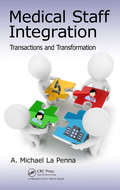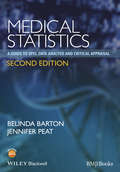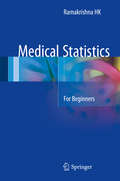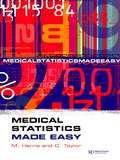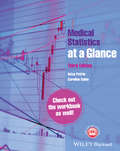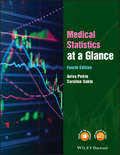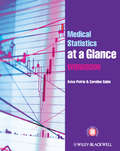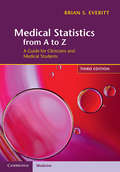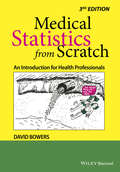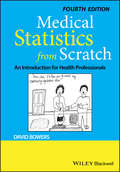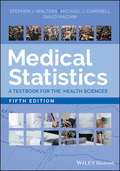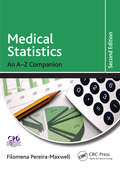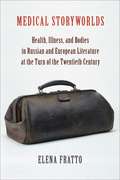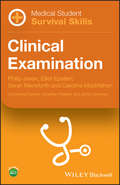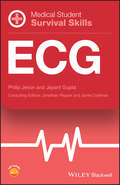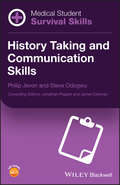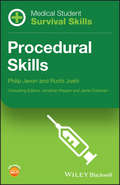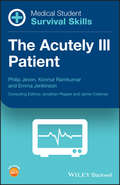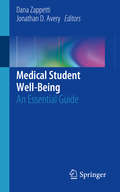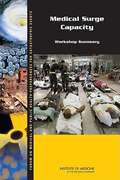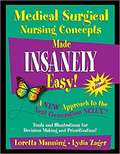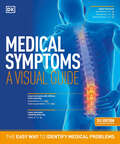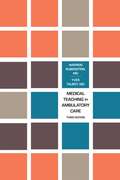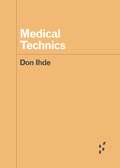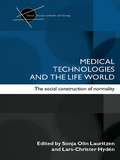- Table View
- List View
Medical Staff Integration: Transactions and Transformation
by A. Michael La PennaThere is a transformation of equity occurring in the health care industry with hospitals and health systems purchasing physician practices. As traditional hospital structures meet the entrepreneurial physician manager in today‘s rapidly changing environment, numerous transitional challenges are emerging. Medical Staff Integration: Transactions and
Medical Statistics
by Belinda Barton Jennifer PeatMedical Statistics provides the necessary statistical tools to enable researchers to undertake and understand evidence-based clinical research. It is a practical guide to conducting statistical research and interpreting statistics in the context of how the participants were recruited, how the study was designed, what types of variables were used, what effect size was found, and what the P values mean. It guides researchers through the process of selecting the correct statistics and show how to best report results for presentation and publication. Clear and concise explanations, combined with plenty of examples and tabulated explanations are based on the authors' popular medical statistics courses. The table of contents is divided into sections according to whether data are continuous or categorical in nature as this distinction is fundamental to selecting the correct statistics. Each chapter provides a clear step-by-step guide to each statistical test with practical instructions on how to generate and interpret the numbers, and present the results as scientific tables or graphs. The chapters conclude with critical appraisal guidelines to help researchers review the reporting of results from each type of statistical test. This new edition includes a new chapter on repeated measures and mixed models and a helpful glossary of terms provides an easy reference that applies to all chapters.
Medical Statistics
by Ramakrishna HkThis book deals with statistics in medicine in a simple way. The text is supported by abundant examples from medical data. This book aims to explain and simplify the process of data presentation. Further aspects addressed include how to design and conduct clinical trials, and how to write journal articles.
Medical Statistics Made Easy
by Michael Harris Gordon TaylorIt is not necessary to know how to do a statistical analysis to critically appraise a paper. However, it is necessary to have a grasp of the basics, of whether the right test has been used and how to interpret the resulting figures. Short, readable, and useful, this book provides the essential, basic information without becoming bogged down in the
Medical Statistics at a Glance (At a Glance)
by Aviva Petrie Caroline SabinMedical Statistics at a Glance is a concise and accessible introduction and revision aid for this complex subject. The self-contained chapters explain the underlying concepts of medical statistics and provide a guide to the most commonly used statistical procedures.This new edition of Medical Statistics at a Glance:Presents key facts accompanied by clear and informative tables and diagramsFocuses on illustrative examples which show statistics in action, with an emphasis on the interpretation of computer data analysis rather than complex hand calculationsIncludes extensive cross-referencing, a comprehensive glossary of terms and flow-charts to make it easier to choose appropriate testsNow provides the learning objectives for each chapterIncludes a new chapter on Developing Prognostic ScoresIncludes new or expanded material on study management, multi-centre studies, sequential trials, bias and different methods to remove confounding in observational studies, multiple comparisons, ROC curves and checking assumptions in a logistic regression analysisThe companion website at www.medstatsaag.com contains supplementary material including an extensive reference list and multiple choice questions (MCQs) with interactive answers for self-assessment.Medical Statistics at a Glance will appeal to all medical students, junior doctors and researchers in biomedical and pharmaceutical disciplines.Reviews of the previous editions"The more familiar I have become with this book, the more I appreciate the clear presentation and unthreatening prose. It is now a valuable companion to my formal statistics course."-International Journal of Epidemiology"I heartily recommend it, especially to first years, but it's equally appropriate for an intercalated BSc or Postgraduate research. If statistics give you headaches - buy it. If statistics are all you think about - buy it."-GKT Gazette"...I unreservedly recommend this book to all medical students, especially those that dislike reading reams of text. This is one book that will not sit on your shelf collecting dust once you have graduated and will also function as a reference book."-4th Year Medical Student, Barts and the London Chronicle, Spring 2003
Medical Statistics at a Glance (At a Glance)
by Aviva Petrie Caroline SabinNow in its fourth edition, Medical Statistics at a Glance is a concise and accessible introduction to this complex subject. Itprovides clear instruction on how to apply commonly used statistical procedures in an easy-to-read, comprehensive and relevant volume. This new edition continues to be the ideal introductory manual and reference guide to medical statistics, an invaluable companion for statistics lectures and a very useful revision aid.This new edition of Medical Statistics at a Glance: Offers guidance on the practical application of statistical methods in conducting research and presenting results Explains the underlying concepts of medical statistics and presents the key facts without being unduly mathematical Contains succinct self-contained chapters, each with one or more examples, many of them new, to illustrate the use of the methodology described in the chapter. Now provides templates for critical appraisal, checklists for the reporting of randomized controlled trials and observational studies and references to the EQUATOR guidelines for the presentation of study results for many other types of study Includes extensive cross-referencing, flowcharts to aid the choice of appropriate tests, learning objectives for each chapter, a glossary of terms and a glossary of annotated full computer output relevant to the examples in the text Provides cross-referencing to the multiple choice and structured questions in the companion Medical Statistics at a Glance Workbook Medical Statistics at a Glance is a must-have text for undergraduate and post-graduate medical students, medical researchers and biomedical and pharmaceutical professionals.
Medical Statistics at a Glance Workbook (At A Glance Ser.)
by Aviva Petrie Caroline SabinThis comprehensive workbook contains a variety of self-assessment methods that allow readers to test their statistical knowledge, put it into practice, and apply it in a medical context, while also providing guidance when critically appraising published literature. It is designed to support the best-selling third edition of Medical Statistics at a Glance, to which it is fully cross-referenced, but may be used independently of it.Ideal for medical students, junior doctors, researchers and anyone working in the biomedical and pharmaceutical disciplines who wants to feel more confident in basic medical statistics, the title includes:* Over 80 MCQs, each testing knowledge of a single statistical concept or aspect of study interpretation* 29 structured questions to explore in greater depth several statistical techniques or principles, including the choice of appropriate statistical analyses and the interpretation of study findings* Templates for the appraisal of clinical trials and observational studies, plus full appraisals of two published papers to demonstrate the use of these templates in practice* Detailed step-by-step analyses of two substantial data sets (also available at www.medstatsaag.com) to demonstrate the application of statistical procedures to real-life researchMedical Statistics at a Glance Workbook is the ideal resource to test statistical knowledge and improve analytical and interpretational skills.Additional resources are available at www.medstatsaag.com, including:* Excel datasets to accompany the data analysis section* Downloadable PDFs of two templates for critical appraisal* Links to online further reading* Supplementary MCQs
Medical Statistics from A to Z: A Guide for Clinicians and Medical Students
by Brian S. EverittFor clinicians not well-versed in mathematical techniques, medical statistics can be baffling. Understanding these statistics is crucial for the interpretation of literature and the informed judgement of the use of therapies. From 'Abortion rate' to 'Zygosity determination', this accessible introduction to the terminology of medical statistics clearly describes, illustrates and explains over 1500 terms using non-technical language, and without any mathematical formulae! The majority of terms have been updated and revised for this new edition, and almost 150 new definitions have been added, ensuring readers are up to date with the latest practices. Entries are organised alphabetically, and related topics are clearly cross-referenced throughout, to provide fast, easy navigation. Further reading suggestions supplement most definitions, which allows readers to deepen their understanding of the subject. Enabling clinicians and medical students to grasp the meaning of any statistical terms they encounter when studying medical literature, this guide is a real lifesaver.
Medical Statistics from Scratch
by David BowersCorrectly understanding and using medical statistics is a key skill for all medical students and health professionals. In an informal and friendly style, Medical Statistics from Scratch provides a practical foundation for everyone whose first interest is probably not medical statistics. Keeping the level of mathematics to a minimum, it clearly illustrates statistical concepts and practice with numerous real world examples and cases drawn from current medical literature. This fully revised and updated third edition includes new material on: missing data, random allocation and concealment of data intra-class correlation coefficient effect modification and interaction diagnostic testing and the ROC curve standardisation Medical Statistics from Scratch is an ideal learning partner for all medical students and health professionals needing an accessible introduction, or a friendly refresher, to the fundamentals of medical statistics.
Medical Statistics from Scratch: An Introduction for Health Professionals
by David BowersCorrectly understanding and using medical statistics is a key skill for all medical students and health professionals.In an informal and friendly style, Medical Statistics from Scratch provides a practical foundation for everyone whose first interest is probably not medical statistics. Keeping the level of mathematics to a minimum, it clearly illustrates statistical concepts and practice with numerous real-world examples and cases drawn from current medical literature. Medical Statistics from Scratch is an ideal learning partner for all medical students and health professionals needing an accessible introduction, or a friendly refresher, to the fundamentals of medical statistics.
Medical Statistics: A Textbook for the Health Sciences
by Michael J. Campbell David Machin Stephen J. WaltersThe 5th edition of this popular introduction to statistics for the medical and health sciences has undergone a significant revision, with several new chapters added and examples refreshed throughout the book. Yet it retains its central philosophy to explain medical statistics with as little technical detail as possible, making it accessible to a wide audience. Helpful multi-choice exercises are included at the end of each chapter, with answers provided at the end of the book. Each analysis technique is carefully explained and the mathematics kept to minimum. Written in a style suitable for statisticians and clinicians alike, this edition features many real and original examples, taken from the authors' combined many years' experience of designing and analysing clinical trials and teaching statistics. Students of the health sciences, such as medicine, nursing, dentistry, physiotherapy, occupational therapy, and radiography should find the book useful, with examples relevant to their disciplines. The aim of training courses in medical statistics pertinent to these areas is not to turn the students into medical statisticians but rather to help them interpret the published scientific literature and appreciate how to design studies and analyse data arising from their own projects. However, the reader who is about to design their own study and collect, analyse and report on their own data will benefit from a clearly written book on the subject which provides practical guidance to such issues. The practical guidance provided by this book will be of use to professionals working in and/or managing clinical trials, in academic, public health, government and industry settings, particularly medical statisticians, clinicians, trial co-ordinators. Its practical approach will appeal to applied statisticians and biomedical researchers, in particular those in the biopharmaceutical industry, medical and public health organisations.
Medical Statistics: An A-Z Companion, Second Edition (An\arnold Publication Ser.)
by Filomena Pereira-MaxwellThis invaluable, jargon-free guide to essential medical terminology in an accessible A-Z format is ideal for medical, allied health and biomedical science students and researchers, clinicians and health care practitioners. Avoiding the complex language that is so often a feature of statistics and research methodology, this text provides clear and succinct explanations, clarifying meaning and showing the interdependencies between important concepts. This edition includes enhanced explanations of statistical concepts and methods—including more illustrative content—for greater accessibility. The book makes frequent use of examples from the medical literature, with reference to landmark studies, ensuring clinical relevance. It remains an ideal aid to accompany the reading and critical appraisal of medical and health care literature, now widely recognized to be a practical lifelong skill required by all health professionals throughout undergraduate and postgraduate studies and during clinical practice.
Medical Storyworlds: Health, Illness, and Bodies in Russian and European Literature at the Turn of the Twentieth Century
by Elena FrattoThough often seen as scientific or objective, medicine has a fundamentally narrative aspect. Much like how an author constructs meaning around fictional events, a doctor or patient narrates the course of an illness and treatment. In what ways have literary and medical storytelling intersected with and shaped each other?In Medical Storyworlds, Elena Fratto examines the relationship between literature and medicine at the turn of the twentieth century—a period when novelists were experimenting with narrative form and the modern medical establishment was taking shape. She traces how Russian writers such as Dostoevsky, Tolstoy, and Bulgakov responded to contemporary medical and public health prescriptions, placing them in dialogue with French and Italian authors including Romains and Svevo and such texts as treatises by Paul Broca and Cesare Lombroso. In nuanced readings of these works, Fratto reveals how authors and characters question the rhetoric and authority of medicine and public health in telling stories of mortality, illness, and well-being. In so doing, she argues, they provide alternative ways of thinking about the limits and possibilities of human agency and free will. Bridging the medical humanities, European literary studies, and Slavic studies, Medical Storyworlds shows how narrative theory and canonical literary texts offer a new lens on today’s debates in medical ethics and bioethics.
Medical Student Survival Skills: Clinical Examination (Medical Student Survival Skills)
by Phil Jevon Elliot Epstein Sarah Mensforth Caroline MacMahonMedical Student Survival Skills: Clinical Examination by Phil Jevon, Elliot Epstein, Sarah Mensforth, Caroline MacMahon
Medical Student Survival Skills: History Taking and Communication Skills (Medical Student Survival Skills)
by Philip Jevon Steve OdogwuMedical students encounter many challenges on their path to success, from managing their time, applying theory to practice, and passing exams. The Medical Student Survival Skills series helps medical students navigate core subjects of the curriculum, providing accessible, short reference guides for OSCE preparation and hospital placements. These guides are the perfect tool for achieving clinical success. Medical Student Survival Skills: History Taking and Communication Skills is a concise and compact guide to obtaining and recording medical histories and achieving positive patient interactions. The first section explores taking history—from initial introduction to identifying symptoms—and includes abdominal and chest pain, dizziness and vertigo, shortness of breath, sexual history, confusion and loss of memory. Essential patient communication skills and strategies for various situations are described in the second section, including angry patients, instances of drug and alcohol abuse, diabetes counselling and breaking bad news.
Medical Student Survival Skills: Procedural Skills (Medical Student Survival Skills)
by Phil Jevon Ruchi JoshiMedical students encounter many challenges on their path to success, from managing their time, applying theory to practice, and passing exams. The Medical Student Survival Skills series helps medical students navigate core subjects of the curriculum, providing accessible short reference guides for OSCE preparation and hospital placements. These guides are the perfect tool for achieving clinical success.
Medical Student Survival Skills: The Acutely Ill Patient (Medical Student Survival Skills)
by Philip Jevon Konnur Ramkumar Emma JenkinsonMedical students encounter many challenges on their path to success, from managing their time, applying theory to practice, and passing exams. The Medical Student Survival Skills series helps medical students navigate core subjects of the curriculum, providing accessible short reference guides for OSCE preparation and hospital placements. These guides are the perfect tool for achieving clinical success.
Medical Student Well-Being: An Essential Guide
by Jonathan D. Avery Dana ZappettiThis book tackles the most common challenges that medical students experience that lead to burnout in medical school by carefully presenting guidelines for assessment, management, clinical pearls, and resources for further references. Written by national leaders in medical student wellness from around the country, this book presents the first model of care for combating one of the most serious problems in medicine. Each chapter is concise and follows a consistent format for readability. This book addresses many topics, including general mental health challenges, addiction, mindfulness, exercise, relationships and many more of the important components that go into the making of a doctor.Medical Student Well-being is a vital resource for all professionals seeking to address physician wellness within medical schools, including medical students, medical education professionals, psychiatrists, addiction medicine specialists, hospitalists, residents, and psychologists.
Medical Surge Capacity: Workshop Summary
by Institute of Medicine of the National AcademiesDuring natural disasters, disease pandemics, terrorist attacks, and other public health emergencies, the health system must be prepared to accommodate a surge in the number of individuals seeking medical help. For the health community, a primary concern is how to provide care to individuals during such high demand, when the health system's resources are exhausted and there are more patients than the system can accommodate. The IOM's Forum on Medical and Public Health Preparedness for Catastrophic Events held a workshop June 10-11, 2009, to assess the capability of and tools available to federal, state, and local governments to respond to a medical surge. In addition, participants discussed strategies for the public and private sectors to improve preparedness for such a surge. The workshop brought together leaders in the medical and public health preparedness fields, including policy makers from federal agencies and state and local public health departments; providers from the health care community; and health care and hospital administrators. This document summarizes the workshop.
Medical Surgical Nursing Concepts Made Insanely Easy!
by I Can PublishingThis book has been written to combine the world of medical diagnoses, the human body's systems and the pathophysiology that occurs with complications to the system with the national accrediting organizations' standards and to connect these with nursing concepts based on practice standards. In order to facilitate the transfer of large amounts of information to the long-term memory, cognitive learning theory has been incorporated throughout the book through the use of mnemonics, songs, jingles, etc.
Medical Symptoms: The Easy Way to Identify Medical Problems (DK Medical Care Guides)
by DKFind home remedies and advice on illnesses and injuries! There are plenty of medical scenarios that can be identified and treated at home. This medical reference book takes you through the most common illnesses and injuries, their symptoms, locations in the body, how to treat them at home and when to seek professional medical attention.Inside this first aid guide, you&’ll find: • Easy-to-access visual symptoms guide, arranged by body part affected, working from head to toe • Intuitive entry-level helps the reader identify illness or locate injury quickly • Clear, simple illustrations of the associated anatomy help medical understanding • Conditions are listed in order of likelihood, with the most likely first, for speedy diagnosis • Symbols direct a reader to the appropriate form of medical help • Concise explanations of all the conditions featured in the diseases and disorders section • Updated to include Covid-19 Medical Symptoms is an easy-to-use visual symptoms finder and self-diagnosis book that will help you check out any health problem. Discover what an ailment or pain might be and what you should do. You&’ll find explanations of symptoms and diseases, clear human anatomy photographs, and suggested home care instructions. Once you&’ve narrowed it down, a cross-reference takes you to easy-to-follow descriptions of the condition at the back of the book. Potentially life-threatening situations symptoms that need urgent medical advice are clearly flagged. This is the perfect home medical guide for your family and is fully illustrated throughout.
Medical Teaching in Ambulatory Care, Third Edition
by Warren Rubenstein Yves TalbotA practical, hands-on resource for physicians in all specialties, Medical Teaching in Ambulatory Care is a guide on training medical students and residents in settings such as private practices and hospital clinics. Concise, engaging, and easy to follow, it is an ideal handbook for the busy practitioner looking to upgrade his or her teaching abilities.The authors cover basic education theory, individual teaching skills, strategies for evaluating trainees, and tips on working with challenging learners. Readers can follow along with the storyline of a fictional Dr. Smith, through whom the book provides practical examples that complement each theory, skill, and strategy presented.This new edition has been updated with key medical education theories that are now core to current approaches, expanded details on one-to-one teaching, and information on structured formats to use when reviewing patient encounters with learners. The authors also examine the impact of digital technology on medical education in office-based settings and provide tips on working with the new generation of learners who enjoy - and expect - instant access to information of all kinds.
Medical Technics (Forerunners: Ideas First)
by Don IhdeA personal account of the aging body and advanced technologies by a preeminent philosopher of technologyMedical Technics is a rigorous examination of how medical progress has modified our worlds and contributed to a virtual revolution in longevity. Don Ihde offers a unique autobiographical tour of medical events experienced in a decade, beginning in his 70s. Ihde offers experiential and postphenomenological analyses of technologies such as sonography and microsurgery, and ultimately asks what it means to increasingly become a cyborg. Forerunners: Ideas FirstShort books of thought-in-process scholarship, where intense analysis, questioning, and speculation take the lead
Medical Technologies and the Life World: The social construction of normality (Critical Studies in Health and Society)
by Lars-Christer Hydén Sonja Olin LauritzenAlthough the use of new health technologies in healthcare and medicine is generally seen as beneficial, there has been little analysis of the impact of such technologies on people’s lives and understandings of health and illness. This ground-breaking book explores how new technologies not only provide hope for cure and well-being, but also introduce new ethical dilemmas and raise questions about the 'natural' body. Focusing on the ways new health technologies intervene into our lives and affect our ideas about normalcy, the body and identity, Medical Technologies and the Life World explores: how new health technologies are understood by lay people and patients how the outcomes of these technologies are communicated in various clinical settings how these technologies can alter our notions of health and illness and create ‘new illness’. Written by authors with differing backgrounds in phenomenology, social psychology, social anthropology, communication studies and the nursing sciences, this sensational text is essential reading for students and academics of medical sociology, health and allied studies, and anyone with an interest in new health technologies.
